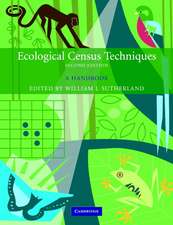Protist Diversity and Geographical Distribution: Topics in Biodiversity and Conservation, cartea 8
Editat de W. Foissner, David Leslie Hawksworthen Limba Engleză Paperback – 14 mar 2012
| Toate formatele și edițiile | Preț | Express |
|---|---|---|
| Paperback (1) | 1376.53 lei 43-57 zile | |
| SPRINGER NETHERLANDS – 14 mar 2012 | 1376.53 lei 43-57 zile | |
| Hardback (1) | 1382.69 lei 43-57 zile | |
| SPRINGER NETHERLANDS – 5 aug 2009 | 1382.69 lei 43-57 zile |
Din seria Topics in Biodiversity and Conservation
- 24%
 Preț: 1605.60 lei
Preț: 1605.60 lei - 18%
 Preț: 1239.49 lei
Preț: 1239.49 lei - 18%
 Preț: 947.50 lei
Preț: 947.50 lei - 18%
 Preț: 1218.21 lei
Preț: 1218.21 lei - 18%
 Preț: 942.31 lei
Preț: 942.31 lei - 18%
 Preț: 944.51 lei
Preț: 944.51 lei -
 Preț: 435.38 lei
Preț: 435.38 lei - 15%
 Preț: 646.62 lei
Preț: 646.62 lei - 24%
 Preț: 806.73 lei
Preț: 806.73 lei - 18%
 Preț: 1114.65 lei
Preț: 1114.65 lei - 18%
 Preț: 1126.35 lei
Preț: 1126.35 lei - 18%
 Preț: 1834.27 lei
Preț: 1834.27 lei - 18%
 Preț: 1019.49 lei
Preț: 1019.49 lei - 18%
 Preț: 1236.38 lei
Preț: 1236.38 lei - 18%
 Preț: 1231.47 lei
Preț: 1231.47 lei - 18%
 Preț: 1236.38 lei
Preț: 1236.38 lei - 18%
 Preț: 1230.66 lei
Preț: 1230.66 lei - 18%
 Preț: 1232.71 lei
Preț: 1232.71 lei - 18%
 Preț: 944.51 lei
Preț: 944.51 lei
Preț: 1376.53 lei
Preț vechi: 1678.69 lei
-18% Nou
Puncte Express: 2065
Preț estimativ în valută:
263.39€ • 275.75$ • 217.94£
263.39€ • 275.75$ • 217.94£
Carte tipărită la comandă
Livrare economică 07-21 aprilie
Preluare comenzi: 021 569.72.76
Specificații
ISBN-13: 9789400736849
ISBN-10: 9400736843
Pagini: 220
Ilustrații: VIII, 211 p.
Dimensiuni: 155 x 235 x 12 mm
Greutate: 0.31 kg
Ediția:2009
Editura: SPRINGER NETHERLANDS
Colecția Springer
Seria Topics in Biodiversity and Conservation
Locul publicării:Dordrecht, Netherlands
ISBN-10: 9400736843
Pagini: 220
Ilustrații: VIII, 211 p.
Dimensiuni: 155 x 235 x 12 mm
Greutate: 0.31 kg
Ediția:2009
Editura: SPRINGER NETHERLANDS
Colecția Springer
Seria Topics in Biodiversity and Conservation
Locul publicării:Dordrecht, Netherlands
Public țintă
ResearchCuprins
Protist diversity and distribution: some basic considerations.- Distribution and diversity of aquatic protists: an evolutionary and ecological perspective.- “Missing” protists: a molecular prospective.- Diversity, dispersal and biogeography of bryophytes (mosses).- Myxomycete diversity and distribution from the fossil record to the present.- Diversity and endemism in Rotifera: a review, and Keratella Bory de St Vincent.- Diversity and geographic distribution of benthic foraminifera: a molecular perspective.- Diversity and biogeography of testate amoebae.- Diversity and geographic distribution of ciliates (Protista: Ciliophora).- The “Tetrahymena pyriformis” complex of cryptic species.- Diversity and geographic distribution of desmids and other coccoid green algae.- The diversity and distribution of diatoms: from cosmopolitanism to narrow endemism.- Dinoflagellate diversity and distribution.- Dispersal and biogeography of silica-scaled chrysophytes.- Conservation of protists: is it needed at all?.
Textul de pe ultima copertă
There is still a widespread belief that microscopic organisms, such as bacteria, fungi, protists, and small multicellulars, have a cosmopolitan distribution due to a presumed easy dispersal by wind and water. However, the contributions collected in this book – ranging from protists to rotifers and mosses – show that microorganisms have community structures and biogeographies similar to those found in animals and vascular plants, although the ranges of many can be wider and local endemism is rarer. Accordingly, the cosmopolitan distribution model of Finlay & Fenchel is to be replaced by the moderate endemicity model of Foissner, which assumes that one third of microscopic organisms are morphological and/or genetic endemics. This has far-reaching consequences for estimates of the number of species and their conservation. There is convincing evidence that we know only about 20% of the actual diversity in many protist groups, especially saprotrophs and heterotrophs such as amoebae, flagellates, and ciliates. It is probable that this great diversity of microscopic organisms is caused by low extinction rates over geological time, and short generation times which foster dispersal of genetic variants. That the great diversity of microorganisms has remained unrecognized for such a long time has several reasons, of which the most serious is a shortage of taxonomists. Considering the dramatic losses of habitats occurring, especially in the tropics, a large portion of the Earth’s protist biodiversity will disappear before it has been discovered.
Reprinted from Biodiversity and Conservation, volume 17:2 (2008)
Reprinted from Biodiversity and Conservation, volume 17:2 (2008)
Caracteristici
Draws together a wide range of peer-reviewed primary research papers from biodiversity researchers around the world Provides examples from a wide spectrum of issues representing the current state of the art in arthropods Provides examples of recent work, usable as case studies for courses in ecology, restoration, biodiversity, conservation Enables specialist researchers to see primary research papers tackling problems in arthropods














